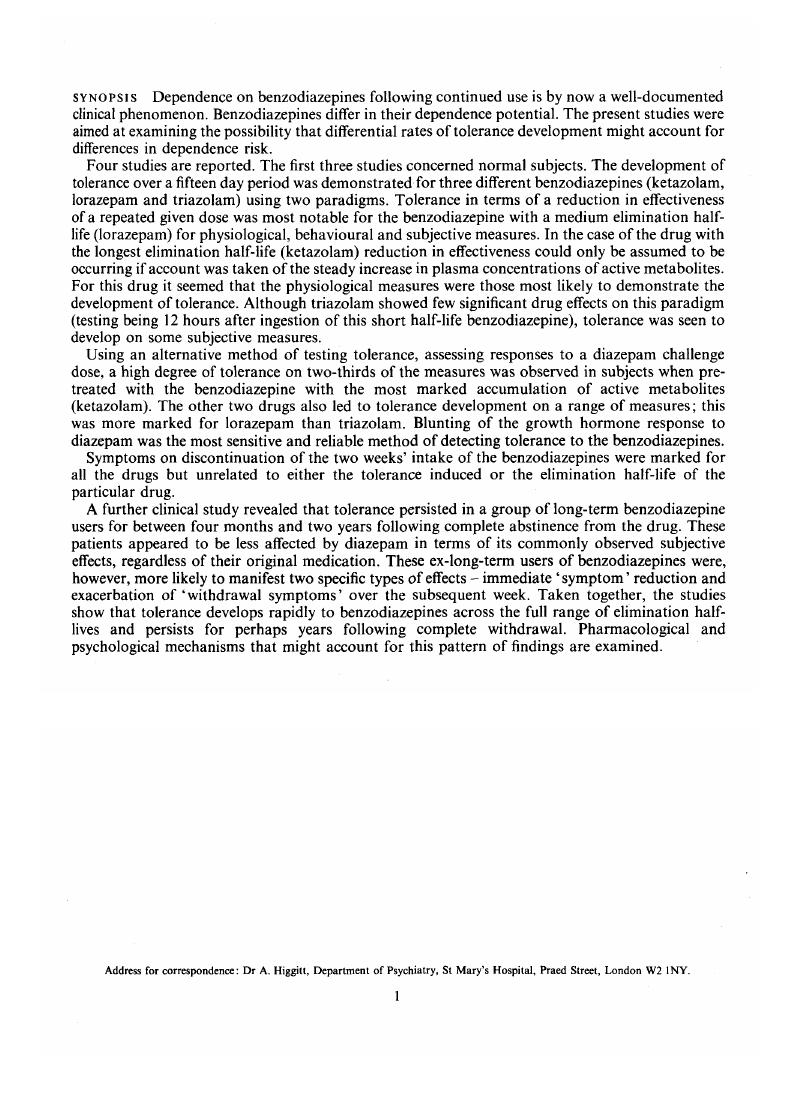Crossref Citations
This article has been cited by the following publications. This list is generated based on data provided by Crossref.
Lader, M.
1988.
Psychopharmacology: Current Trends.
p.
169.
Barnas, C.
Fleischhacker, W. W.
Whitworth, A. B.
Schett, P.
Stuppäck, C.
and
Hinterhuber, H.
1991.
Characteristics of benzodiazepine long-term users: investigation of benzodiazepine consumers among pharmacy customers.
Psychopharmacology,
Vol. 103,
Issue. 2,
p.
233.
Brandon, Sydney
1993.
Panic disorder: Clinical perspectives.
Journal of Psychiatric Research,
Vol. 27,
Issue. ,
p.
11.
Fernandes, Cathy
File, Sandra E.
and
Berry, Dave
1996.
Evidence against oppositional and pharmacokinetic mechanisms of tolerance to diazepam's sedative effects.
Brain Research,
Vol. 734,
Issue. 1-2,
p.
236.
Jongsma, Marijtje L.A
Van Rijn, Clementina M
De Bruin, Eveline A
Dirksen, Ris
and
Coenen, Anton M.L
1998.
Time course of chronic diazepam effects on the auditory evoked potential of the rat.
European Journal of Pharmacology,
Vol. 341,
Issue. 2-3,
p.
153.
Elliot, E.E
and
White, J.M
2000.
Precipitated and Spontaneous Withdrawal Following Administration of Lorazepam But Not Zolpidem.
Pharmacology Biochemistry and Behavior,
Vol. 66,
Issue. 2,
p.
361.
Sarid‐Segal, Ofra
Knapp, Clifford M.
Ciraulo, Ann Marie
Greenblatt, David J.
Shader, Richard I.
and
Ciraulo, Domenic A.
2000.
Decreased EEG Sensitivity to Alprazolam in Subjects with a Parental History of Alcoholism.
The Journal of Clinical Pharmacology,
Vol. 40,
Issue. 1,
p.
84.
Azar, Nabil J.
Lagrange, Andre H.
Wang, Lily
Song, Yanna
and
Abou‐Khalil, Bassel W.
2010.
Transient improvement after brief antiepileptic drug withdrawal in the epilepsy monitoring unit—possible relationship to AED tolerance.
Epilepsia,
Vol. 51,
Issue. 5,
p.
811.
Lader, Malcolm
2011.
Benzodiazepines revisited—will we ever learn?.
Addiction,
Vol. 106,
Issue. 12,
p.
2086.
Lopez-Peig, Cristina
Mundet, Xavier
Casabella, Bartomeu
del Val, Jose Luis
Lacasta, David
and
Diogene, Eduard
2012.
Analysis of benzodiazepine withdrawal program managed by primary care nurses in Spain.
BMC Research Notes,
Vol. 5,
Issue. 1,
Dell’osso, B.
and
Lader, M.
2013.
Do Benzodiazepines Still Deserve a Major Role in The Treatment of Psychiatric Disorders? A Critical Reappraisal.
European Psychiatry,
Vol. 28,
Issue. 1,
p.
7.
Quines, Caroline B.
Da Rocha, Juliana T.
Sampaio, Tuane B.
Pesarico, Ana Paula
Neto, José S.S.
Zeni, Gilson
and
Nogueira, Cristina W.
2015.
Involvement of the serotonergic system in the anxiolytic-like effect of 2-phenylethynyl butyltellurium in mice.
Behavioural Brain Research,
Vol. 277,
Issue. ,
p.
221.
Waters, Laura
Manchester, Kieran R.
Maskell, Peter D.
Haegeman, Caroline
and
Haider, Shozeb
2018.
The use of a quantitative structure-activity relationship (QSAR) model to predict GABA-A receptor binding of newly emerging benzodiazepines.
Science & Justice,
Vol. 58,
Issue. 3,
p.
219.
Ehret, Megan
2019.
Treatment of posttraumatic stress disorder: Focus on pharmacotherapy.
Mental Health Clinician,
Vol. 9,
Issue. 6,
p.
373.
Raffa, Robert B.
2020.
The Benzodiazepines Crisis.
p.
81.
Tan, Sean Yilong
Chandran, Nisha Suyien
and
Choi, Ellie Ci-En
2021.
Steroid Phobia: Is There a Basis? A Review of Topical Steroid Safety, Addiction and Withdrawal.
Clinical Drug Investigation,
Vol. 41,
Issue. 10,
p.
835.
Lou, Becky X.
and
Oks, Margarita
2021.
Insomnia.
Clinics in Geriatric Medicine,
Vol. 37,
Issue. 3,
p.
401.
Wheless, James W.
Friedman, Daniel
Krauss, Gregory L.
Rao, Vikram R.
Sperling, Michael R.
Carrazana, Enrique
and
Rabinowicz, Adrian L.
2022.
Future opportunities for research in rescue treatments.
Epilepsia,
Vol. 63,
Issue. S1,



